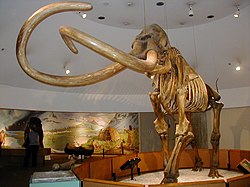Columbian mammoth - Simple English Wikipedia, the free encyclopedia
| Columbian mammoth | |
|---|---|
 | |
| Columbian mammoth | |
| Scientific classification | |
| Kingdom: | |
| Class: | |
| Order: | |
| Family: | |
| Genus: | |
| Binomial name | |
| Mammuthus columbi (Blumenbach, 1799) | |
The Columbian mammoth (Mammuthus columbi), or Imperial mammoth, was a species of mammoth which lived late in the Pleistocene period.[1] Its remains have been found in Canada, the United States, Nicaragua and Mexico.[2]
The Columbian mammoth went extinct at the end of the ice ages about 11,000 years ago. It shared the fate of many other large mammals, whose extinction is attributed to hunting and climate change.[3]
DNA studies show that the Columbian mammoth was a hybrid between woolly mammoths and another lineage descended from steppe mammoths. This hybridization happened more than 420,000 years ago.
These mammoths did not live in the Arctic regions of Canada, where the woolly mammoth lived. The ranges of the two species may have overlapped, and genetic evidence suggests that they interbred. Several sites have the skeletons of more than one Columbian mammoths. Maybe they died in incidents such as a drought, or perhaps these places were natural traps where individuals tended to die.
References
[change | change source]- ↑ Jacob Enk; et al. (2011). "Complete Columbian mammoth mitogenome suggests interbreeding with woolly mammoths". Genome Biology. 12 (5). BioMed Central: R51. doi:10.1186/gb-2011-12-5-r51. PMC 3219973. PMID 21627792.
- ↑ "†Mammuthus columbi Falconer 1857 (Columbian mammoth)". Fossilworks. Archived from the original on 4 March 2016. Retrieved 18 February 2014.
- ↑ Martin P.S. & Klein R.G. (eds) 1984. Quarternary extinctions: a prehistoric revolution. Tucson: Arizona University Press. ISBN


 French
French Deutsch
Deutsch